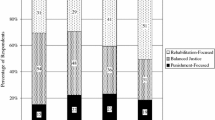Abstract
The Family Group Conference (FGC) originated in New Zealand where it is the foundation stone of the Youth Justice system introduced in 1989. A significant feature of that system is the way in which it enables restorative justice principles to be implemented in an integrated manner in a statutory framework supervised by the courts and applicable to all young offenders throughout New Zealand. FGCs are used both as a diversionary technique (pre-adjudication) and at a (post-adjudication) pre-sentencing stage. In addition this type of model is now being applied in a voluntary way but on a small scale with adults. A significant feature of the FGC model is its greater use of community-based solutions with a consequent reduction in the number of young persons in state institutions.
Similar content being viewed by others
REFERENCES
Alder, C. and J. Wundersitz (Eds), Family Group Conferencing and Juvenile Justice. The Way Forward or Misplaced Optimism? Canberra, Australia: Australian Institute of Criminology, 1994.
Barry, K., Restorative Justice: Reflection from the UK on Practice in New Zealand. Address to the Institute of Criminology, Victoria University of Wellington, October 28, 1997.
Blagg, H., A Just Measure of Shame? Aboriginal Youth and Conferencing in Australia. British Journal of Criminology, 37(4), pp. 481-501, 1997.
Consedine, J., Restorative Justice: Healing the Effects of Crime. Lyttelton, New Zealand: Ploughshares, 1995.
Henwood, C., The Children, Young Persons, and Their Families Act 1989: The New Zealand Situation 1997: A Judicial Perspective. Paper presented to the Australian Law Commission, 1997.
Hyndman, M., M. Thorsborne and S. Wood, Community Accountability Conferencing: Trial report. Queensland: Department of Education, 1996.
Maxwell, G.M., Funding Youth Justice 1990-1994. Children, 15, 1994.
Maxwell, G.M. and A. Morris, article, Commonwealth Judicial Journal, 9(4), 1992.
Maxwell, G.M. and A. Morris, The New Zealand Model of Family Group Conferences. In: C. Alder and J. Wundersitz (Eds), Family Group Conferencing and Juvenile Justice. The Way Forward or Misplaced Optimism? Canberra, Australia: Australian Institute of Criminology, 1994.
Maxwell, G.M. and A. Morris, What do we know about juvenile crime? In: G. Maxwell and A. Morris (Eds), Youth Justice: The Vision. Proceedings of a National Conference, Victoria University of Wellington, 1996a.
Maxwell, G.M. and A. Morris, Research on Family Group Conferences with young offenders in New Zealand. In: B. Galaway et al. (Eds), Family Group Conferences: Perspectives on Policy and Practice. New York: Criminal Justice Press, 1996b.
McElrea, F.W.M., The intent of the Children, Young Persons and their Families Act 1989: restorative justice? Youth Law Review, July/August/September, 1994a.
McElrea, F.W.M., The New Zealand Youth Court: a model for development in other courts? Journal of Judicial Administration, 4(1), p. 33, 1994b (republished as chapter 3 of B. Galaway and J. Hudson (Eds), Restorative Justice: International Perspectives. New York: Criminal Justice Press, 1996).
McElrea, F.W.M., Accountability in the community: taking responsibility for offending. In: Re-Thinking Criminal Justice Volume 1. Auckland: Legal Research Foundation, 1995.
McElrea, F.W.M., What relevance might restorative justice have in cases of rape? In: J. Broadmore, C. Shand and T. Warburton, RAPE: Ten Years' Progress? Proceedings of an inter-disciplinary conference, p. 109, Wellington, New Zealand, March 27-30, 1996.
McElrea, F.W.M., Restorative justice: A peace making process. Paper presented to the Fifth International LEADR Conference on Alternative Dispute Resolution. Perth, Australia, May 9-11, 1997a.
McElrea, F.W.M., 'Win-win' solutions to school conflict. Paper presented to the Australia and New Zealand Education Law Association's conference Contemporary Issues in Education Law: Strategies for Best Practice, Sydney, Australia, July 7-9, 1997b.
New Zealand Judiciary, Report of the New Zealand Judiciary 1995. Wellington: Department for Courts, 1996. Report of the Working Party on Interdepartmental Strategy for Improved Management of Youth Justice Remand Placements, pp. 4-5 and 4-6, July 29, 1997.
Spier, P., Conviction and Sentencing of Offenders in New Zealand: 1985 to 1994.Wellington: Ministry of Justice, 1995.
Spier, P., Conviction and Sentencing of Offenders in New Zealand 1987 to 1996. Wellington: Ministry of Justice, 1997.
Stuart, B., Circle sentencing: turning swords into ploughshares. In: B. Galaway and J. Hudson (Eds), Restorative Justice: International Perspectives. New York: Criminal Justice Press, 1996.
Walters, R., Punitive responses to juvenile crime: do they work? Youth Justice: The Vision. Proceedings of a National Conference, Victoria University of Wellington, October 31, 1996.
Zehr, H., Changing Lenses: A New Focus for Crime and Justice. Scottdale, Pennsylvania: Herald Press, 1990.
Author information
Authors and Affiliations
Rights and permissions
About this article
Cite this article
McElrea, J.F. The New Zealand Model of Family Group Conferencing. European Journal on Criminal Policy and Research 6, 527–543 (1998). https://doi.org/10.1023/A:1008696514447
Issue Date:
DOI: https://doi.org/10.1023/A:1008696514447




